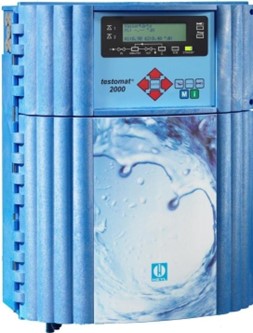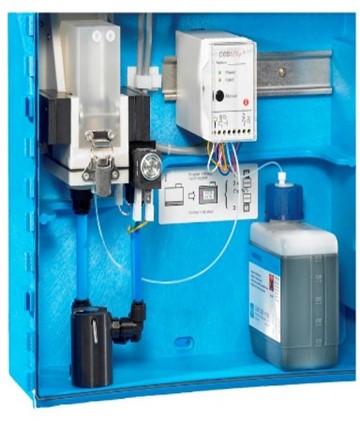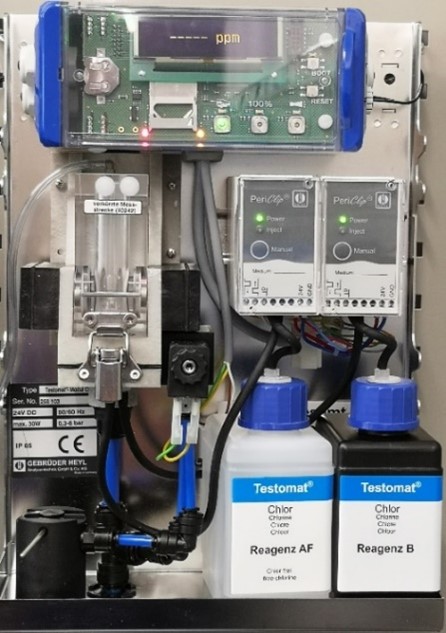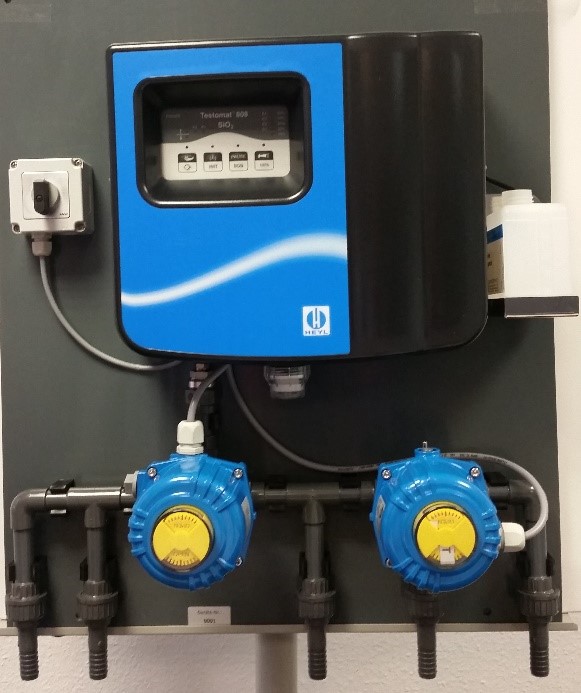The online analyzer TESTOMAT®
The Testomat® 2000 has been in use worldwide since the early 2000s for reliable monitoring of water treatment plants in industry and municipal facilities. The compactly designed online analyzer is mainly used for measuring water hardness and for the alkalinity parameters carbonate hardness, m- or p-value.

Testomat® 2000 Online Analyzer

Interior view with optical measuring chamber,
dosing pump for reagents (max. 4 pcs.) and 500 ml bottle.
The robust, field-proof device (protection class IP 65) enables the operator to monitor two measuring points and thus two plant areas. The measured value can be transmitted to a higher-level control system via a 4-20 mA signal. 2 limit values can be monitored by means of potential-free contacts.
The evaluation of the titration methods used is carried out photometrically via the color changes of the reagents in the optically visible wavelength range.
Water hardness is determined by means of complexometric titration with an eriochrome black indicator and EDTA at pH 9 according to DIN 38409. The water hardness range of 0.05 - 25 °dH can be recorded by using different, specially adapted indicators.
Carbonate hardness is determined as alkalinity from acid/base titration to pH 4.3 (+m value) according to EN ISO 9963. The measuring range is 0.18 - 7.14 mmol/l (8.9 - 358 ppm CaCO3) depending on the reagents used. The determination of the -m value can also be carried out and covers the range 0.05 - 0.5 mmol/l. Titration to pH 8.2 yields the +p value in the measuring range 0.1 - 15 mmol/l. The m- and p-values are mainly used for the reliable control of boiler feed and boiler water to be able to comply with the requirements for water quality and corrosion behavior.
But Testomat® 2000 does more than just determine water hardness
In the chemical treatment of boiler feed water, conditioning agents are used for pH adjustment (alkalization), the binding of dissolved oxygen and to prevent scale deposits (hardness stabilization) and corrosion. The dosing process, chemical efficacy and concentration of chemical products, such as sulfite and phosphates, in feed and boiler water must be verified based on the respective guidelines and regulations. In contrast to quick tests, only continuous online analysis with Testomat® 2000 can enable sustainable operational reliability:
The conditioning of recirculating water in recooling plants also requires sustained control of critical quality parameters, such as pH, conductivity and the chemical agents added to prevent salinization, lime deposits and corrosion. In addition to monitoring phosphate-containing products (see above), conditioning agents based on polymers, such as polyacrylates, can be measured in the cooling water with the Testomat® 2000 to provide a reliable assessment of cooling water quality in correlation to dosing quantities and the chemical/physical influence of the active ingredients on the water matrix:
The VDI guidelines VDI 2047-2 and 3803-3.4 require the operator of the recooling plant to ensure hygienic operating conditions. Accordingly, a biocide treatment program must be planned, especially for legionella prophylaxis. The dosage and decay behavior of chlorine-containing products and odorless chlorine dioxide can be continuously monitored and documented:
Chlorine measurement is also possible with the newly developed online analyzer Testomat® LAB CL. The instruments of this series are connected to an external PLC or a higher-level controller and can be parameterized by means of PC software. This instrument technology is particularly suitable for integration in multiparameter solutions with analog and digital data communication.

Offener Aufbau mit optischer Messkammer, Zwei Dosierpumpen für zwei Reagenzien (500 ml Flaschen); Option mit Display
Further application examples for the use of Testomat® analyzers for the measurement of chlorine dioxide, free or total chlorine according to the DPD method:
- Water and plant disinfection with chlorine dioxide in the food industry
- Legionella control and biofilm degradation by chlorine dioxide
- Chlorination of drinking water supply networks and reservoirs
- Monitoring of the degradation of residual chlorine in process water to protect membranes
- Reference measuring system for chlorine measurement in laboratories, waterworks, etc.
- Swimming pool water disinfection with chlorine-containing products
In water treatment for swimming pools, products containing bromine can be used as disinfectants as an alternative to chlorine, depending on the system concept and country-specific regulations. Compared to chlorine, bromine dissolved in water is odorless and less aggressive on materials:
The treatment of well water requires reliable filtration or deferrization to ensure the permissible drinking water or process water quality. An increased content of dissolved iron in process waters can be very critical for food production or in other industrial areas. Accordingly, online monitoring of dissolved iron (Fe II and Fe III) with the Testomat® 2000 is more reliable than random color comparison tests:
Chromate compounds are produced during metal processing, electroplating and dyeing processes and must be removed from wastewater due to their high toxicity. Continuous monitoring of the chromate content during the treatment process increases the safety in the elimination of this critical substance:
The supply of ultrapure water to clean steam generators for autoclaves and sterilizers in hospitals requires sustained control of important water parameters such as conductivity, residual hardness and silicate content. If the limit values of DIN EN 285 are exceeded, discoloration, deposits and corrosion can lead to permanent damage to surgical instruments. The quality of the sterile material must therefore be ensured by continuous monitoring of the ultrapure water quality.
The silicate in the demineralized water is measured using a specially developed Testomat analyzer:

In summary, it can be stated that the Testomat® online analyzers are convincing not only in the reliable measurement of water hardness, but also in the control of important dosing agents, such as sulfite, phosphate or chlorine, and critical water constituents, such as iron, chromate or silicate.